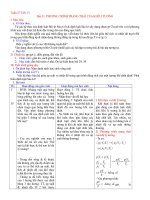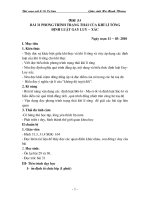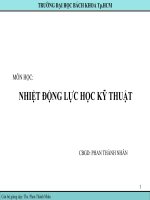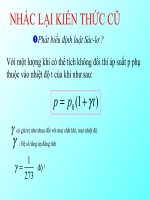Nghiên cứu phương trình trạng thái của chất hạt nhân cân bằng beta trong sao neutron và sao protoneutron (Equation of state of the betastable nuclear matter for neutron and protoneutron stars)
Bạn đang xem bản rút gọn của tài liệu. Xem và tải ngay bản đầy đủ của tài liệu tại đây (1.33 MB, 148 trang )
MINISTRY OF SCIENCE
MIMISTRY OF EDUCATION
AND TECHNOLOGY
AND TRAINING
VIETNAM ATOMIC ENERGY INSTITUTE
PhD THESIS
presented by
Ngo Hai Tan
EQUATION OF STATE OF THE BETA-STABLE
NUCLEAR MATTER IN NEUTRON STARS AND
PROTO-NEUTRON STARS
Supervisor: Prof. Dao Tien Khoa
Abstract
This thesis presents the results of a consistent mean-field study for
the equation of state (EOS) of the β-stable baryonic matter containing
npeµν particles in the core of cold neutron star (NS) and hot proto-neutron
star (PNS). Within the non-relativistic Hartree-Fock formalism, different
choices of the in-medium, density-dependent nucleon-nucleon (NN) interaction have been used. Although the considered density dependent NN
interactions have been well tested in numerous nuclear structure and/or
reaction studies, they give rather different behaviors of the nuclear symmetry energy at high baryonic densities which were discussed in the literature as the stiff and soft scenarios for the EOS of asymmetric NM. A
strong impact of the nuclear symmetry energy to the mean-field prediction
of the cooling scenario for NS and thermodynamic properties of the PNS
matter has been found in our study. In addition to the nuclear symmetry
energy, the nucleon effective mass in the high-density medium was found
also to affect the thermal properties of hot β-stable baryonic matter of
PNS significantly.
Given the EOS of the crust of NS and PNS from the compressible
liquid drop model and relativistic mean-field approach, respectively, the
different EOS’s of the core of NS and PNS were used as input for the
Tolman-Oppenheimer-Volkov equations to obtain the structure of NS and
PNS in the hydrostatic equilibrium, in terms of the gravitational mass,
radius, central baryonic density, pressure and temperature. For the PNS
matter, both the neutrino-free and neutrino-trapped baryonic matters in
β-equilibrium were investigated at different temperatures and entropy per
baryon S/A = 1, 2 and 4. The obtained results show consistently the
strong impact of the nuclear symmetry energy and nucleon effective mass
on the thermal properties and composition of hot PNS matter. Maximal
ii
gravitation masses obtained with different EOS’s for the neutrino-free βstable PNS at S/A = 4 were used to assess the time of the collapse of a
very massive PNS to black hole, based on the results of the hydrodynamic
simulation of a failed supernova of the 40 M⊙ protoneutron progenitor.
The effective, density dependent CDM3Yn interaction has been shown to
be quite reliable in the mean-field description of the EOS of both the cold
and hot asymmetric NM.
iii
Acknowledgements
First and foremost, I gratefully express my best thanks to my supervisor, Prof. Dao Tien Khoa for his longtime tutorial supervision of my
research study at the Institute for Nuclear Science and Technology (INST)
in Hanoi, ever since I graduated from Hanoi University of Pedagogy. Prof.
Khoa has really inspired me to pursuit research in nuclear physics by his
deep knowledge in teaching and coaching his students and young collaborators, and his strict demand on every detail of the research work. I would
also like to thank Dr. J´erˆome Margueron from IPN Lyon for his collaboration work in the topic of my PhD Thesis and support of my short visit
to IPN Lyon as well as my attendance at some international meetings in
Europe. I have gained good skills of the nuclear physics research during
my short visits to IPN Orsay and IPN Lyon, and I am deeply grateful to
Prof. Nguyen Van Giai from IPN Orsay for his help and encouragement.
I would like to thank my fellow PhD student, Ms. Doan Thi Loan,
who gave very important contribution to our common research project on
the mean-field description of the equation of state of nuclear matter. We
have accomplished together many interesting tasks and share a lot of joint
memories during the years working at INST as PhD students. I wish to
express my thanks also to my colleagues in the nuclear physics center at
INST, in particular, Dr Do Cong Cuong and Mr. Nguyen Hoang Phuc
for their useful discussions and kind friendship that made the working
atmosphere in our group very pleasant and lively. The helpful discussions
on different physics problems with Dr. Bui Minh Loc, a frequent visitor at
INST from University of Pedagogy of Ho Chi Minh City, are also thankfully
acknowledged
The present research work has been supported, in part, by National
Foundation for Science and Technology Development (NAFOSTED) of
iv
Vietnam, Groupe de Physique Theorique of IPN Orsay at Universite ParisSud XI Orsay and IPN Lyon, the Palse program of Lyon University, the
LIA collaboration in nuclear physics research between MOST of Vietnam
and CNRS and CEA of France. I am also grateful to INST and Nuclear
Training Center of VINATOM for hosting my research stay at INST within
the PhD program of VINATOM.
v
Abbreviations
NM
Nuclear matter
ANM Asymmetric Nuclear matter
EOS
Equation of state
HF
Hartree-Fock
BHF
Br¨
uckner Hartree-Fock
D
Direct
EX
Exchange
NS
Neutron star
PNS
Proto-neutron star
n
neutron
p
proton
NN
nucleon-nucleon
IS
Iso-scalar
IV
Iso-vector
vi
Contents
Abstract . . . . . . . . . . . . . . . . . . . . . . . . . . . . . . .
ii
Acknowledgements . . . . . . . . . . . . . . . . . . . . . . . . .
iv
Abbreviations . . . . . . . . . . . . . . . . . . . . . . . . . . . .
vi
List of tables . . . . . . . . . . . . . . . . . . . . . . . . . . . .
xi
List of figures . . . . . . . . . . . . . . . . . . . . . . . . . . . .
xix
1 Introduction
1
2 Hartree-Fock formalism for the mean-field study of NM
9
2.1
2.2
2.3
Effective density-dependent NN interaction . . . . . . . . .
13
2.1.1
CDM3Yn effective interaction . . . . . . . . . . . .
14
2.1.2
M3Y-Pn interactions . . . . . . . . . . . . . . . . .
18
2.1.3
Gogny interaction . . . . . . . . . . . . . . . . . . .
20
2.1.4
Skyrme interaction . . . . . . . . . . . . . . . . . .
22
Explicit Hartree-Fock expressions . . . . . . . . . . . . . .
23
2.2.1
The finite range interactions . . . . . . . . . . . . .
23
2.2.2
Zero-range Skyrme interaction . . . . . . . . . . . .
26
HF results for the cold asymmetric nuclear matter . . . . .
27
2.3.1
Saturation properties . . . . . . . . . . . . . . . . .
27
2.3.2
Total energy of cold NM . . . . . . . . . . . . . . .
31
2.3.3
Nuclear matter pressure . . . . . . . . . . . . . . .
33
2.3.4
Symmetry energy . . . . . . . . . . . . . . . . . . .
35
vii
3 HF study of the β-stable NS matter
40
3.1
β equilibrium constraint . . . . . . . . . . . . . . . . . . .
41
3.2
EOS of the β-stable npeµ matter . . . . . . . . . . . . . .
43
3.2.1
Composition of the npeµ matter . . . . . . . . . . .
43
3.2.2
The cooling of neutron star . . . . . . . . . . . . .
47
3.2.3
Pressure of the β-stable npeµ matter . . . . . . . .
49
Cold neutron star in hydrodynamical equilibrium . . . . .
51
3.3.1
Mass-radius relation . . . . . . . . . . . . . . . . .
52
3.3.2
Total baryon mass . . . . . . . . . . . . . . . . . .
57
3.3.3
Surface red-shift . . . . . . . . . . . . . . . . . . . .
59
3.3.4
Binding energy . . . . . . . . . . . . . . . . . . . .
60
3.3.5
Causality condition . . . . . . . . . . . . . . . . . .
60
3.3
4 Hartree-Fock study of hot nuclear matter
4.1
4.2
63
Explicit HF expressions . . . . . . . . . . . . . . . . . . . .
66
4.1.1
The finite range interactions . . . . . . . . . . . . .
66
4.1.2
Zero-range Skyrme interaction . . . . . . . . . . . .
69
HF results for the EOS of hot ANM . . . . . . . . . . . . .
70
4.2.1
Helmholtz free energy . . . . . . . . . . . . . . . .
70
4.2.2
Free symmetry energy . . . . . . . . . . . . . . . .
75
4.2.3
Impact of nucleon effective mass on the thermaldy-
4.2.4
namical properties of NM . . . . . . . . . . . . . .
79
Entropy . . . . . . . . . . . . . . . . . . . . . . . .
83
5 HF study of the β-stable PNS matter
89
5.1
β equilibrium constraint . . . . . . . . . . . . . . . . . . .
90
5.2
EOS of PNS matter . . . . . . . . . . . . . . . . . . . . . .
93
5.2.1
Impact of the free symmetry energy . . . . . . . . .
93
5.2.2
Impact of the in-medium nucleon effective mass . .
101
Proto-neutron star in the hydrodynamical equilibrium . . .
103
5.3
viii
Conclusion
113
References
118
List of author’s publications in the present research topic . . . .
ix
129
List of Tables
2.1
Parameters of the central term V (C) (r12 ) in the original M3Y
Paris and M3Y-Pn (n=3,4,5) interactions [15]. . . . . . . .
2.2
Parameters of the density dependence (2.20) of CDM3Yn
interaction [8, 9] . . . . . . . . . . . . . . . . . . . . . . . .
2.3
15
17
Ranges and strengths of Yukawa functions used in the radial dependence of the M3Y-Paris, M3Y-P5, and M3Y-P7
interactions [15, 16]. . . . . . . . . . . . . . . . . . . . . .
2.4
Parameters of the density-dependent term v (DD) (nb , r12 )[15,
16] . . . . . . . . . . . . . . . . . . . . . . . . . . . . . . .
2.5
19
Ranges and strengths of Gaussian functions used in the radial dependence of the D1S and D1N interactions [10, 11].
2.6
18
21
HF results for the NM saturation properties using the considered effective NN interactions. The nucleon effective mass
m∗ /m is evaluated at δ = 0 and E0 = E(n0 , δ = 0)/A. Ksym
is the curvature parameter of the symmetry energy (2.6),
and Kτ is the symmetry term of the nuclear incompressibility (2.57) determined at the saturation density nδ of asymmetric NM. . . . . . . . . . . . . . . . . . . . . . . . . . .
x
29
3.1
Configuration of static neutron star given by different NS
equations of state: maximum gravitational mass MG , radius
RG , and moment of inertia IG ; maximum central densities
nc , ρc and pressure Pc ; total baryon number A; surface redshift zsurf ; binding energy Ebind . . . . . . . . . . . . . . . .
5.1
56
Properties of the ν-free and ν-trapped, β-stable PNS at entropy per baryon S/A = 0, 1, 2 and 4, given by the solutions of the TOV equations using the EOS’s based on the
CDM3Y3, CDM3Y6 interactions [9] and their soft CDM3Y3s,
CDM3Y6s versions [6]. Mmax and Rmax are the maximum
gravitational mass and radius; nc , ρc , Pc , and Tc are the
baryon number density, mass density, total pressure, and
temperature in the center of PNS. Ts is temperature of the
outer core of PNS, at baryon density ρs ≈ 0.63×1015 g/cm3 .
Results at S/A = 0 represent the stable configuration of cold
(ν-free) NS [6]. . . . . . . . . . . . . . . . . . . . . . . . .
5.2
105
The same as Table 5.1 but obtained with the EOS’s based
on the SLy4 version [19] of Skyrme interaction, M3Y-P7
interaction parametrized by Nakada [16], and D1N version
[18] of Gogny interaction. . . . . . . . . . . . . . . . . . . .
xi
107
List of Figures
1.1
Structure of neutron star. ( . . . . . . . . . . . . . . . . . . . . . . . .
1.2
4
Density dependence of the energy (per baryon) of NM energy given by the HF calculation using the CDM3Y3 and
CDM3Y6 versions [8] of the M3Y-Paris interaction, which
are associated with the nuclear incompressibility K = 218
and 252 MeV, respectively. . . . . . . . . . . . . . . . . . .
2.1
6
Total NM energy per particle E/A at different neutronproton asymmetries δ given by the HF calculations using
the CDM3Y3 (lower panel) and CDM3Y6 (upper panel) interactions. The solid circles are the saturation densities of
the NM at the different neutron-proton asymmetries. . . .
2.2
30
Total NM energy per particle E/A for symmetric NM (upper
panel) and pure neutron matter (lower panel) given by the
HF calculation using different interactions. The circles and
crosses are results of the ab-initio calculation by Akmal,
Pandharipande and Ravenhall (APR) [52] and microscopic
Monter Carlo (MMC) calculation by Gandolfi et al. [53],
respectively. . . . . . . . . . . . . . . . . . . . . . . . . . .
xii
32
2.3
Pressure of symmetric NM (upper panel) and pure neutron
matter (lower panel) calculated in the HF approximation
using the effective NN interactions given in Table 2.6. The
shaded areas are the empirical constraints deduced from the
HI flow data [59]. . . . . . . . . . . . . . . . . . . . . . . .
2.4
34
HF results for the NM symmetry energies Esym (nb ) given
by the density-dependent NN interactions under study. The
shaded (magenta) region marks the empirical boundaries deduced from the analysis of the isospin diffusion data and
double ratio of neutron and proton spectra data of HI collisions [60, 61]. The square and triangle are the constraints
deduced from the consistent structure studies of the GDR
[62] and neutron skin [50], respectively. The circles and
crosses are results of the ab-initio calculation by Akmal,
Pandharipande and Ravenhall (APR) [52] and microscopic
Monter Carlo (MMC) calculation by Gandolfi et al. [53],
respectively. . . . . . . . . . . . . . . . . . . . . . . . . . .
3.1
36
The fractions xj = nj /nb of constituent particles of the NS
matter obtained from the solutions of Eqs. (3.4) and (3.6)
using the mean-field potentials given by the M3Y-P5 and
D1N interactions. . . . . . . . . . . . . . . . . . . . . . . .
3.2
44
The same as Fig. 3.1 but using the mean-field potentials
given by the M3YP7 and Sly4 interactions. The circles are
nj values calculated at the maximum central densities nc
given by the solution of the TOV equations. . . . . . . . .
3.3
45
The same as Fig. 3.2 but using the mean-field potentials
given by the CDM3Y6 and its soft version interactions. . .
xiii
46
3.4
The proton fraction xp of the β-stable NS matter obtained
from the solutions of Eqs. (3.4) and (3.6) using the meanfield potentials given by the stiff-type CDM3Yn and Sly4
interactions. The circles are np values calculated at the maximum central densities nc given by the TOV equations. The
thin lines are the corresponding DU thresholds (3.11).
3.5
. .
47
The pressure inside the NS matter obtained with the inmedium NN interactions that give stiff (upper panel) and
soft (lower panel) behavior of Esym (nb ), in comparison with
the empirical data points deduced from the astronomical observation of neutron stars [83]. The shaded band shows the
uncertainties associated with the data determination. The
circles are P values calculated at the corresponding maximum central densities given by the TOV equations. . . . .
3.6
50
The NS gravitational mass versus its radius in comparison
¨
with the empirical data (shaded contours) deduced by Ozel
et al [83] from recent astronomical observations of neutron
stars. The circles are values calculated at the maximum central densities. The thick solid (red) line is the limit allowed
by General Relativity [79]. . . . . . . . . . . . . . . . . . .
3.7
53
The same as Fig. 3.6, but in comparison with the empirical
data (shaded contours) deduced by Steiner et al. [80] from
the observation of the X-ray burster 4U 1608-52. . . . . . .
3.8
54
The gravitational mass M given by different EOS’s of the NS
matter plotted versus the corresponding total baryon mass
Mb . The shaded rectangle is the empirical value inferred
from observations of the double pulsar PSR J0737-3059 by
Podsiadlowski et al. [81]. . . . . . . . . . . . . . . . . . . .
xiv
58
3.9
The adiabatic sound velocity versus baryon density obtained
with the EOS’s given by the stiff-type (upper panel) and
soft-type (lower panel) in-medium NN interactions. The
thick solid (red) lines are the subluminal limit (vs
c),
and the vertical arrows indicate the baryon densities above
which the NS matter predicted by the M3Y-P7 interaction
becomes superluminal (see details in the text). . . . . . . .
4.1
61
Free energy per particle F/A of symmetric nuclear matter
(SNM) and pure neutron matter (PNM) at different temperatures given by the HF calculation using the CDM3Y3 (right
panel) and CDM3Y6 (left panel) interactions [9] (lines), in
comparison with the BHF results (symbols) by Burgio and
Schulze [27]. . . . . . . . . . . . . . . . . . . . . . . . . . .
4.2
71
The same as Fig. 4.1 but for the HF results obtained with the
M3Y-P5 (right panel) and M3Y-P7 (left panel) interactions
parametrized by Nakada [15, 16]. . . . . . . . . . . . . . .
4.3
72
The same as Fig. 4.1 but for the HF results obtained with
the D1N version [18] of Gogny interaction (left panel) and
SLy4 version [19] of Skyrme interaction (right panel). . . .
4.4
73
Pressure of ANM (upper panel) and PNM (lower panel) at
T=0,20,40 MeV compare to the analysis of the collective
data measured in relativistic HI collision [59]. . . . . . . .
4.5
74
Free symmetry energy per particle Fsym /A of pure neutron
matter (δ = 1) at different temperatures given by the HF
calculations (4.29) using the CDM3Y3 and CDM3Y6 interactions [9] and their soft versions CDM3Y3s and CDM3Y6s
[6] (lines), in comparison with the BHF results (symbols) by
Burgio and Schulze [27]. . . . . . . . . . . . . . . . . . . .
xv
75
4.6
The same as Fig. 4.4 but for the HF results given by the
M3Y-P5 and M3Y-P7 interactions parametrized by Nakada
[15, 16], and the D1N version [18] of Gogny interaction and
SLy4 version [19] of Skyrme interaction. . . . . . . . . . .
4.7
76
Free symmetry energy (4.29) (lower panels) and internal
symmetry energy (4.31) (upper panels) at different temperatures, given by the HF calculations using the CDM3Y6
interaction [9]. (Fsym /A)/δ 2 curves must be very close if the
quadratic approximation (4.30) is valid. . . . . . . . . . . .
4.8
77
Density profile of the neutron- (upper panel) and proton effective mass (lower panel) at different neutron-proton asymmetries δ given by the HF calculation using the CDM3Y6
and CDM3Y3 interactions [9], and the D1N version of Gogny
interaction [18], in comparison with the BHF results (symbols) by Baldo et al. [71]. . . . . . . . . . . . . . . . . . .
4.9
80
The same as Fig. 4.8 but for the HF results obtained with
the M3Y-P7 and M3Y-P5 interactions [15, 16], and the SLy4
version [19] of Skyrme interaction. . . . . . . . . . . . . . .
81
4.10 Density profile of temperature in the isentropic and symmetric NM given by the HF calculation using different density
dependent NN interactions, in comparison with that given
by the approximation (4.34) for the fully degenerate Fermi
(DF) system at T ≪ TF . . . . . . . . . . . . . . . . . . . .
82
4.11 Density profile of entropy per particle S/A of symmetric
nuclear matter (SNM) and pure neutron matter (PNM) at
different temperatures, deduced from the HF results (lines)
obtained with the CDM3Y6 and CDM3Y3 interactions [9],
in comparison with the BHF results by Burgio and Schulze
(symbols) [27]. . . . . . . . . . . . . . . . . . . . . . . . . .
xvi
84
4.12 The same as Fig. 4.6 but for the HF results obtained with
the M3Y-P7 and M3Y-P5 interactions [15, 16]. . . . . . . .
85
4.13 The same as Fig. 4.6 but for the HF results obtained with
the D1N version [18] of Gogny interaction and SLy4 version
[19] of Skyrme interaction. . . . . . . . . . . . . . . . . . .
86
4.14 Symmetry part of the entropy per particle (4.33) of pure
neutron matter at different temperatures given by the CDM3Y3
and CDM3Y6 interactions [9] and their soft CDM3Y3s and
CDM3Y6s versions [6]. Ssym /A is scaled by the corresponding temperature to have the curves well distinguishable at
different T . . . . . . . . . . . . . . . . . . . . . . . . . . .
5.1
87
Total pressure (5.10) of the isentropic ν-free (left panel) and
ν-trapped (right panel) β-stable PNS matter at different
baryon densities nb and entropy per baryon S/A = 1, 2 and
4. The EOS of the PNS crust is given by the RMF calculation by Shen et al. [5], and the EOS of the uniform PNS
core is given by the HF calculation using the CDM3Y6 interaction [9] (upper panel) and its soft CDM3Y6s version
[6] (lower panel). The transition region matching the PNS
crust with the uniform core is shown as the dotted lines. .
5.2
94
Neutron-proton asymmetry δ of the ν-free (left panels) and
ν-trapped (right panels) β-stable PNS matter at different
baryon number densities nb and entropy per baryon S/A =
1, 2 and 4. The EOS of the homogeneous PNS core is given
by the HF calculation using the CDM3Y6 interaction [9] and
its soft CDM3Y6s version [6]. . . . . . . . . . . . . . . . .
xvii
95
5.3
Entropy per baryon (upper panel) and temperature (lower
panel) as function of baryon number density nb of the βstable PNS matter given by the CDM3Y6 interaction [13, 9]
(thick lines) and its soft CDM3Y6s version [6] (thin lines)
in the ν-free (left panel) and ν-trapped (right panel) cases.
5.4
96
Particle fractions as function of baryon number density nb in
the ν-free and β-stable PNS matter at entropy per baryon
S/A = 1, 2 and 4, given by the CDM3Y6 interaction [9]
(upper panel) and its soft CDM3Y6s version [6] (lower panel). 97
5.5
The same as Fig. 5.4 but for the ν-trapped, β-stable matter
of the PNS. . . . . . . . . . . . . . . . . . . . . . . . . . .
5.6
98
The same as Fig. 5.4, but given by the SLy4 version [19] of
Skyrme interaction (upper panel) and M3Y-P7 interaction
parametrized by Nakada [16] (lower panel). . . . . . . . . .
5.7
The same as Fig. 5.6 but for the ν-trapped, β-stable PNS
matter. . . . . . . . . . . . . . . . . . . . . . . . . . . . . .
5.8
99
100
Density profile of neutron and proton effective mass in the νfree and β-stable PNS matter at entropy per baryon S/A =
1, 2 and 4, given by the HF calculation using the CDM3Y6
[9] and M3Y-P7 [16] interactions (left panel), the D1N version of Gogny interaction [18] (right panel) and SLy4 version
[19] of Skyrme interaction (right panel). . . . . . . . . . . .
5.9
102
Density profile of temperature in the ν-free and β-stable
PNS matter at entropy per baryon S/A = 1, 2 and 4, deduced from the HF results obtained with the same density
dependent NN interactions as those considered in Fig. 5.8.
xviii
103
5.10 Gravitational mass (in unit of solar mass M⊙ ) of the βstable, ν-free (left panel) and ν-trapped (right panel) PNS
at entropy S/A = 1, 2 and 4 as function of the radius (in
km), based on the EOS of the homogeneous PNS core given
by the CDM3Y6 interaction [9] (upper panel) and its soft
CDM3Y6s version [6] (lower panel). The circle at the end
of each curve indicates the last stable configuration. . . . .
104
5.11 The same as Fig. 5.10 but given by the CDM3Y3 interaction
[9] (upper panel) and its soft CDM3Y3s version [6] (lower
panel). . . . . . . . . . . . . . . . . . . . . . . . . . . . . .
106
5.12 The same as Fig. 5.10 but given by the SLy4 version of
Skyrme interaction [19] (upper panel) and M3Y-P7 interaction parametrized by Nakada [16] (lower panel). . . . . . .
108
5.13 Delay time tBH from the onset of the collapse of a 40 M⊙
progenitor until the black hole formation as function of the
enclosed gravitational mass MG (open squares) given by the
hydrodynamic simulation [76, 4], and Mmax values given by
the solution of the TOV equations using the same EOS for
the ν-free and β-stable PNS at S/A = 4 (open circles). The
Mmax values given by the present mean-field calculation of
the ν-free and β-stable PNS at S/A = 4 using different density dependent NN interactions are shown on the correlation
line interpolated from the results of simulation. . . . . . .
xix
111
Chapter 1
Introduction
With the physics of unstable neutron-rich nuclei being at the forefront of modern nuclear physics, the determination of the equation of state
(EOS) of asymmetric neutron-rich nuclear matter (NM) becomes also an
important research goal in many theoretical and experimental studies. Although, in general concept, asymmetric NM is an idealized infinite uniform
matter composed of strongly interacting baryons and (almost free) leptons
at different mass densities and neutron-proton asymmetries, it is in fact a
real physical condition existing in neutron stars which can be observed
from Earth through their radiation of X-rays or radio signals. Up to now,
about 2000 neutron stars have been detected (mostly as radio pulsars) in
the Milky Way and Large Magellanic Cloud, with the observed gravitation
mass of the most massive neutron stars reaching around or slightly above
two solar masses (MG ≈ 2.01 ± 0.04 M⊙ ). Above this value stars evolve
into black holes. For different theoretical studies, such a large neutron star
mass should be possible with the realistic EOS of neutron star matter.
In the terrestrial laboratories, the interior of a heavy neutron-rich nucleus
like lead or uranium can be considered as a small fragment of asymmetric
NM, and some basic properties of asymmetric NM were deduced from the
structure studies of heavy nuclei with neutron excess. Very important are
1
2
Chapter 1. Introduction
the saturation properties of NM, in particular, the internal energy pressure
of the symmetric NM (infinite nuclear matter with the same neutron and
proton densities) around the saturation baryon number density n0 ≈ 0.17
fm−3 . In terms of thermodynamics, EOS often means the dependence of
the pressure P on the mass density ρ and temperature T of NM, while in
the many-body studies of NM it is often discussed as the dependence of
the internal NM energy on the baryon number density and temperature.
From the nuclear astrophysics viewpoint, a realistic EOS of neutron
star matter is a vital input for the astrophysical studies for the structure
and formation of cold neutron star (NS) as well as hot proto-neutron star
(PNS). Proto-neutron stars are compact and very hot and neutrino-rich
stellar objects which have the shortest stellar life time in the Universe (it
is around one minute between the birth of PNS following the gravitational
collapse of a massive progenitor and the appearance of a black hole or
a neutron star). Nevertheless, many complex physics phenomena occur
during these seconds, with PNS contracting, cooling down and eventually
losing all its neutrino content. Very important for the hydrodynamical
modeling of a compact PNS or NS are its gravitational mass and radius in
the hydrostatic equilibrium. With a given EOS of the β-stable neutron rich
matter, the mass-radius (M/R) relation of NS or PNS can be determined
from the solution of the Tolman-Oppenheimer-Volkov (TOV) equations
[1], which were derived from the Einstein theory of the general relativity
assuming the spherical symmetry of the stellar object
(
)(
)(
)−1
dP
mρ
P
4πP r3
2Gm
= −G 2 1 + 2
1+
1−
,
dr
r
ρc
mc2
rc2
dm
= 4πr2 ρ,
dr
(1.1)
where G is the universal gravitational constant, P and ρ are the pressure
and mass energy density of NS or PNS, r is the radial coordinate in the
Schwarzschild metric, and m is the gravitational mass enclosed within the
3
sphere of radius r. As discussed below in the present thesis, the TOV equations (1.1) are solved numerically using the realistic P (ρ) relation given by
a chosen EOS of the matter inside NS or PNS. As such, EOS means not
only P (ρ) but also the composition of the stellar matter. Nuclear astrophysics is an interdisciplinary field that is actively developed and carried
out at different nuclear physics centers in recent years [2]. The nuclear
astrophysical modeling of the stellar object is based in many cases on the
astrophysical observations and extrapolations of what we consider reliable
physical knowledge of the EOS of NM tested in terrestrial laboratories.
In fact, the combined use of the astrophysical and nuclear physics data in
the astrophysical studies also offers a unique opportunity to test different
theoretical nuclear models.
In the hot environment of PNS, the entropy per baryon S/A is believed
to be of the order of 1 or 2 Boltzmann constant kB [3] (in the present work
we assume kB = 1). However, the recent astrophysical studies have suggested that S/A might well exceed 4 in the hot core of PNS during a failed
supernova [4], when a very massive progenitor collapses directly to black
hole. Such an environment is so extreme that neutrinos are first trapped
within the PNS matter in the beginning of the core collapse. Then, on a
time scale of 10-20 s PNS is cooling down mainly through electron neutrino
emission, and after about 40-50 s the PNS matter becomes transparent to
neutrinos. For a newborn NS, the cooling via neutrino emission can take
place for 100 to 105 years before the γ cooling period begins [1]. Thus,
the knowledge about the EOS of the hot, asymmetric NM is vital for the
astrophysics studies of both NS and PNS. From the surface of NS and
PNS inwards, the baryon matter first forms a low-density, inhomogeneous
crust and, with the increasing baryon density, the matter gradually forms
a uniform core (see Fig. 1.1).
Given the EOS’s of the crust of NS and PNS given by the compressible
4
Chapter 1. Introduction
Figure 1.1: Structure of neutron star.
( />
liquid drop model and relativistic mean-field approach, respectively, different EOS’s of the uniform core of NS and PNS predicted in the present
mean-field approach have been used as the input for the TOV equations
(1.1) to obtain the basic stellar characteristics in the hydrostatic equilibrium, like the M/R relation between the gravitational mass and radius,
central matter density and pressure. These results were compared with the
available empirical data to verify the reliability of the considered EOS’s of
asymmetric NM in the astrophysical modeling of NS and PNS.
The key quantity to distinguish different nuclear EOS’s of NM is the
5
nuclear mean-field potential that can be obtained from a consistent meanfield study, like the relativistic mean-field (RMF) approach [5] or nonrelativistic Hartree-Fock (HF) formalism [6] based on the realistic choice of the
nucleon-nucleon (NN) interaction in the high-density nuclear medium. To
deduce an in-medium NN interaction starting from the free NN interaction
to the form amenable for different nuclear structure and reaction calculations still remains a challenge for the microscopic nuclear many-body
theories. Therefore, most of the nuclear reaction and structure studies still
use different kinds of the effective (density-dependent) NN interaction as
in-medium interaction between nucleons. Microscopic many-body studies
have shown consistently the strong effect by the Pauli blocking as well
as higher-order NN correlations with the increasing baryon density. Such
medium effects are normally considered as the physics origin of the empirical density dependence introduced into various versions of the effective
NN interaction used in the HF mean-field approaches. For example, the
density dependent CDM3Yn versions [8, 9] of the M3Y interaction, which
was originally constructed to reproduce the G-matrix elements of the Reid
[10] and Paris [11] NN potentials in an oscillator basis.
In searching for a realistic choice of the effective NN interaction for the
consistent use in the mean-field studies of NM and finite nuclei as well as
in the nuclear reaction calculations, we have performed in the present work
a systematic HF study of asymmetric NM at both zero and finite temperatures using the CDM3Yn interactions, which have been used mainly in the
folding model studies of the nuclear scattering [8, 12, 13, 14], and the M3YPn interactions carefully parametrized by Nakada [15, 16] for use in the
HF studies of nuclear structure. For comparison, the same HF study has
also been done with the D1S and D1N versions of the Gogny interaction
[17, 18] and Sly4 version of the Skyrme interaction [19]. In the mean-field
studies, the EOS of NM is usually associated with density dependence of
6
Chapter 1. Introduction
the total energy of NM (per baryon) which is expressed as
E
E
(nb , δ) = (nb , δ = 0) + Esym (nb )δ 2 + O(δ 4 ) + ...
(1.2)
A
A
where the baryon number density (nb = nn + np ) is the sum of the neutron
and proton number densities, δ = (nn − np )/nb is the asymmetry parameter, and Esym (nb ) is the so-called symmetry energy. A foremost requisite
to the realistic in-medium NN interaction is that it should give the proper
description of the saturation properties of symmetric NM, i.e., the binding
E
energy of symmetric NM of around (n0 , δ = 0) ≈ −16 MeV at the satuA
ration density n0 , like the HF results obtained with the density dependent
CDM3Y3 and CDM3Y6 versions [8] of the M3Y-Paris interaction shown
in Fig 1.2.
80
EOS for cold Nuclear Matter
60
CDM3Y3 (K=218 MeV)
CDM3Y6 (K=252 MeV)
E/A(MeV)
40
20
0
-20
0
1
2
3
4
0
Figure 1.2: Density dependence of the energy (per baryon) of NM energy given by the
HF calculation using the CDM3Y3 and CDM3Y6 versions [8] of the M3Y-Paris interaction, which are associated with the nuclear incompressibility K = 218 and 252 MeV,
respectively.
Very vital quantity for the determination of the EOS of asymmetric
NM is the nuclear symmetry energy, especially, the behavior of Esym (nb )









